Google Nexus 4 and Nexus 10 Performance Preview
by Anand Lal Shimpi & Brian Klug on November 2, 2012 11:00 AM ESTGPU Performance
This section is particularly exciting because it's our first look at ARM's new Mali-T604 GPU in our standard mobile 3D performance suite. We've already seen the Nexus 4's Adreno 320 in action, but the Nexus 10's behavior here should be interesting to see.
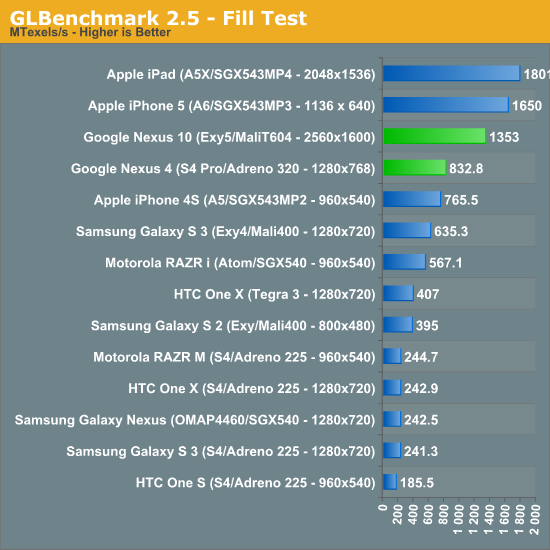
As far as raw fillrates are concerned, both Nexus devices do quite well here at their native resolutions. The iPad and iPhone 5 are both quicker, but we're still good gains over the previous generation of hardware - particularly for the Mali-T604. Compared to the Mali-400MP4 in the Galaxy S 3, we're seeing more than 2x the performance out of ARM's latest GPU.
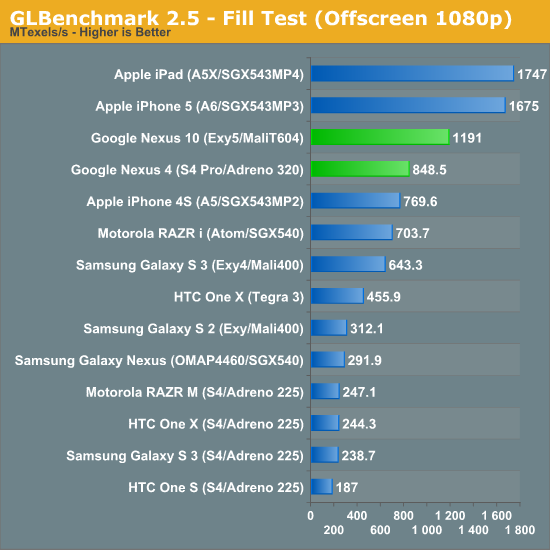
At normalized resolutions the standings don't really change.
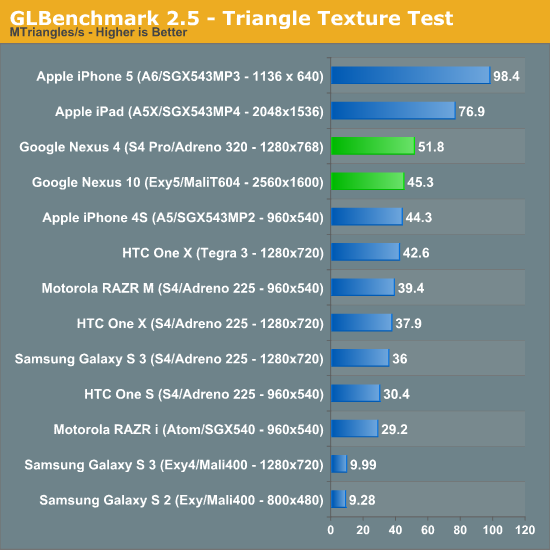
The T604 is ARM's first unified shader architecture, which gives it far more balanced pixel/vertex shader performance. The result is a more than 4x increase in triangle throughput compared to the Mali 400MP4. It's not enough to give the Nexus 10 the edge over the latest Apple devices, but it's a huge improvement over where ARM was in the previous generation. The Adreno 320 continues to be quite strong here as well.
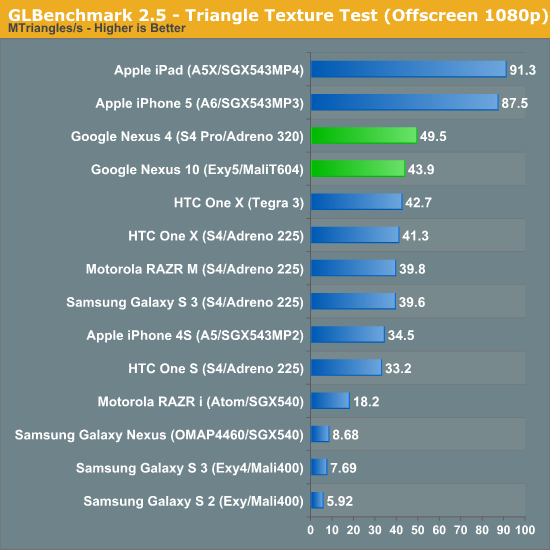
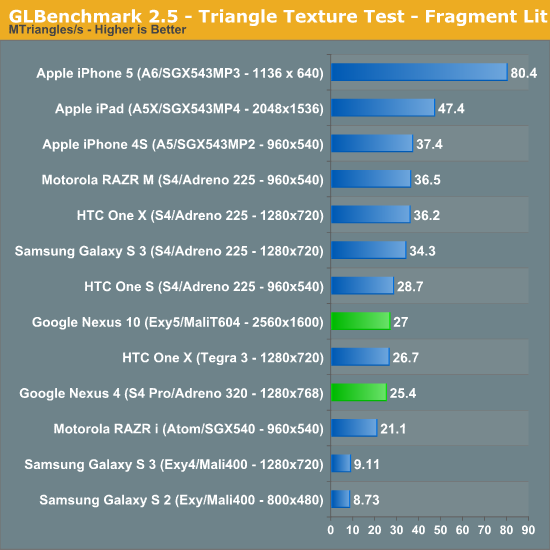
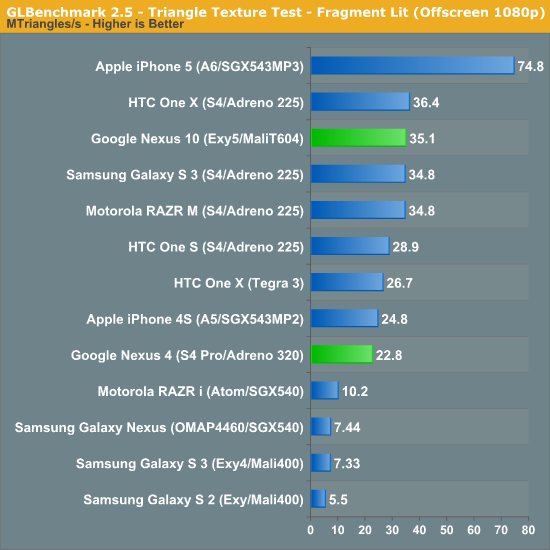
Once again we're seeing huge gains for the Mali-T604 compared to the Mali-400MP4. The Adreno 320 in the Nexus 4 actually performs worse than the Adreno 225 in older devices, possibly due to thermal throttling we saw on the Nexus 4 sample during periods of heavy load.
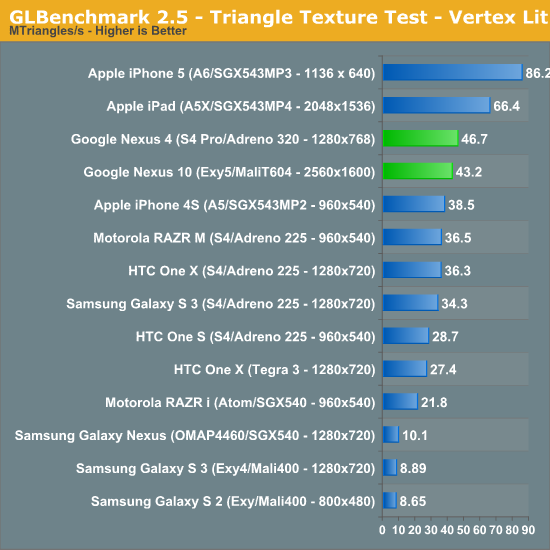
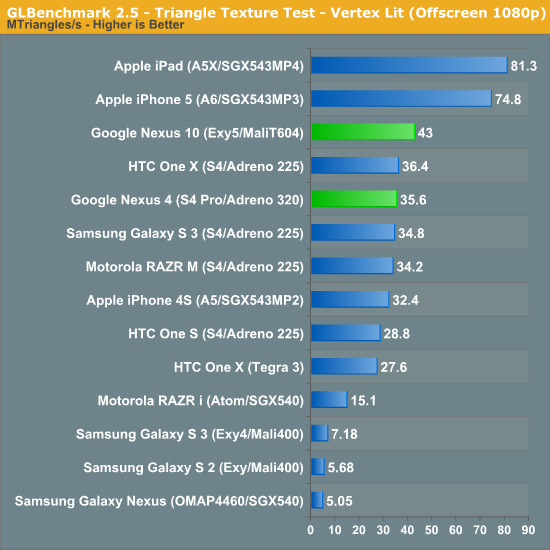
ARM shows the biggest gains here once again thanks to its move to a unified shader architecture. The Adreno 320 does ok here but it's really no better than the 225, I suspect there is some thermal throttling happening on the device.
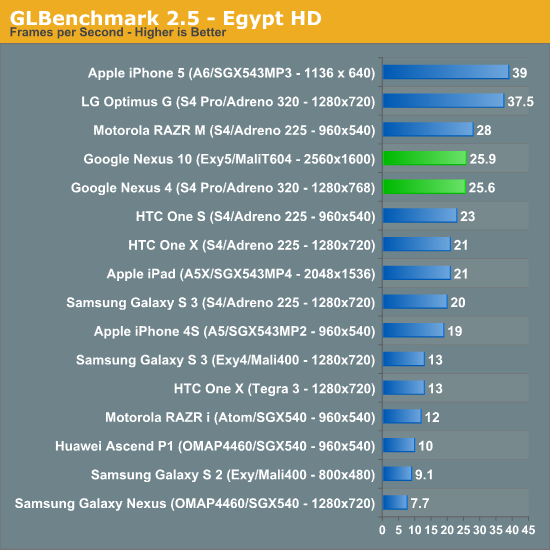
At native resolutions, the Nexus 10 and NExus 4 are both capable of putting out decent frame rates in Egypt HD. What this data tells us is they'll likely be able to run current and even some future titles, at native res, at 30 fps without much of an issue.
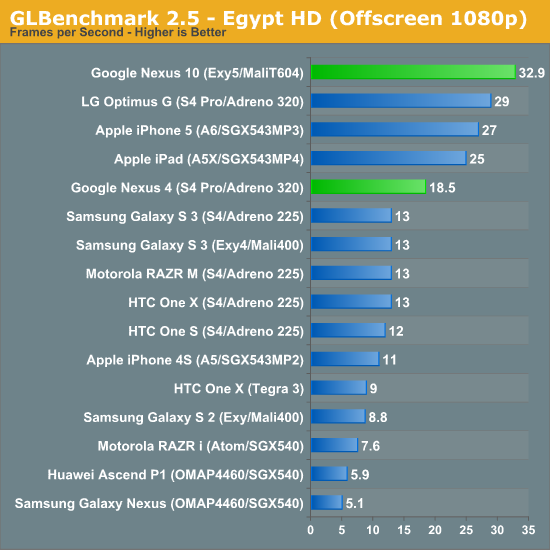
Normalize resolution and the Mali-T604 actually does very well here, setting a new performance record. Despite being based on the same hardware, the Optimus G is able to post a much higher score here than the Nexus 4. The explanation is simple: the Optimus G can't complete a single, continuous run of GLBenchmark 2.5 - the app will run out of texture memory and crash if you try to run through the entire suite in a single setting. The outcome is that the Optimus G avoids some otherwise nasty throttling. The Nexus 4 on the other hand manages to complete everything, but likely quickly throttles its clocks down due to thermal constraints. The Nexus 4 was really hot by the end of our GLBenchmark run, which does point to some thermal throttling going on here. I do wonder if the Snapdragon S4 Pro is a bit too much for a smartphone, and is better suited for a tablet at 28nm.
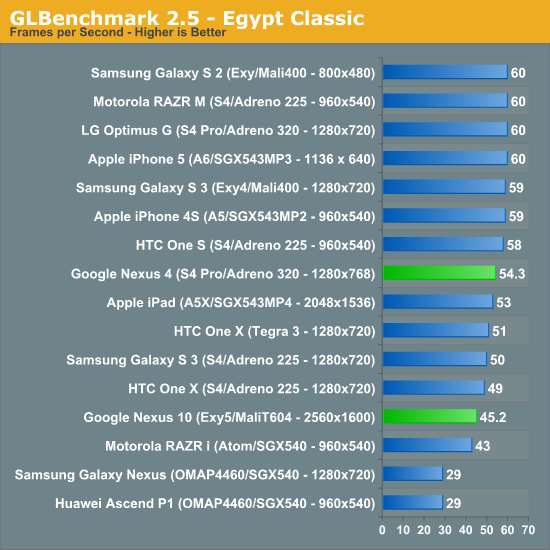
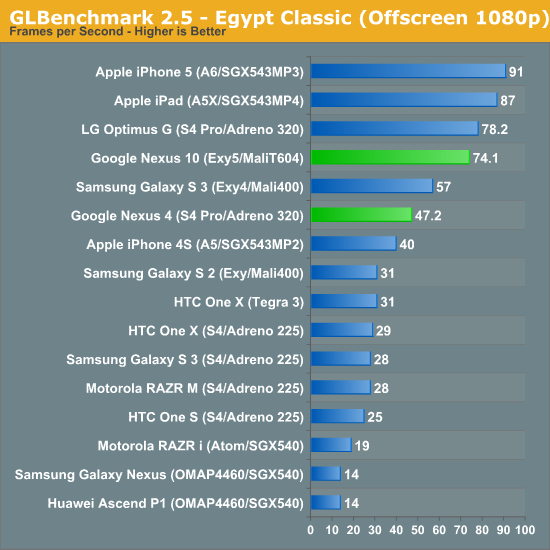
The Egypt Classic numbers are less interesting, but both platforms do well here.
Battery Life
We didn't have time to run through our entire battery life suite, but we do have some relevant results for the two devices. For smartphones, these are our latest web browsing battery life tests:
We regularly load web pages at a fixed interval until the battery dies (all displays are calibrated to 200 nits as always). The differences between this test and our previous one boil down to the amount of network activity and CPU load.
On the network side, we've done a lot more to prevent aggressive browser caching of our web pages. Some caching is important otherwise you end up with a baseband test, but it's clear what we had previously wasn't working. Brian made sure that despite the increased network load, the baseband still had the opportunity to enter its idle state during the course of the benchmark.
We also increased CPU workload along two vectors: we decreased pause time between web page loads and we shifted to full desktop web pages, some of which are very js heavy. The end result is a CPU usage profile that mimics constant, heavy usage beyond just web browsing. Everything you do on your smartphone ends up causing CPU usage peaks - opening applications, navigating around the OS and of course using apps themselves. Our 5th generation web browsing battery life test should map well to more types of smartphone usage, not just idle content consumption of data from web pages.
As always we test across multiple air interfaces (3G, 4G LTE, WiFi), but due to the increased network load we actually find that on a given process technology we see an increase in battery life on faster network connections. The why is quite simple to understand: the faster a page is able to fully render, the quicker all components can drive down to their idle power states.
All Android tests use Chrome and 5GHz WiFi unless otherwise listed.
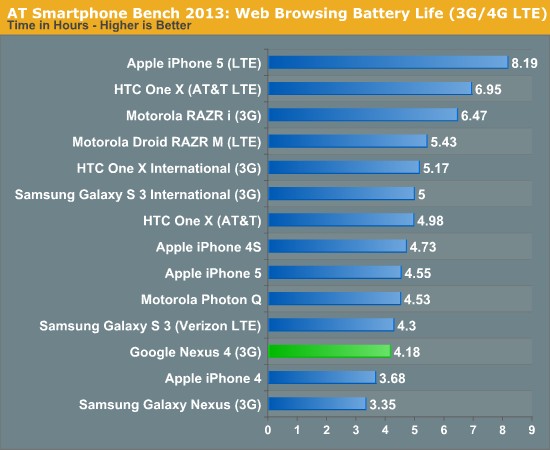
The Nexus 4 doesn't break any records for 3G battery life, it ends up relatively low on our list - even the Galaxy S 3 manages to do better here on 3G.

WiFi battery life is similar to the Galaxy S 3, but again it's not all that impressive compared to some of the other devices in this list.
Our tablet web browsing battery life test isn't directly comparable to the new smartphone tests, so we've got a separate chart for the Nexus 10:
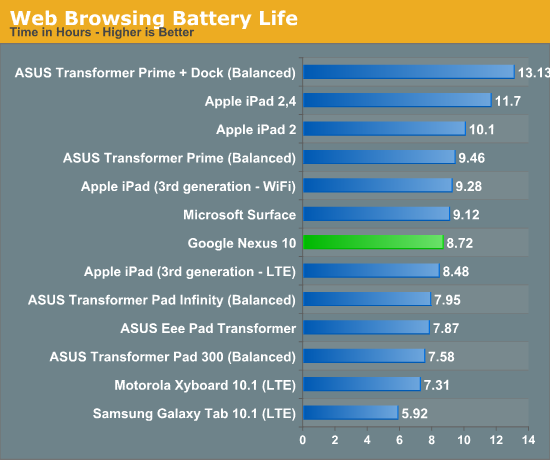
Despite driving a very high res panel, Google is able to deliver relatively competitive battery life with the Nexus 10. Battery capacity is around 80% the size of the 3rd gen iPad and battery life is around 93% of what Apple delivers here. Over 10 hours would be nice to have, but 8 hours of use in this test isn't bad at all. We'll have to do more testing to understand Exynos 5's power behavior a bit better, but so far it doesn't seem that the platform is all that bad from a power consumption standpoint. It remains to be seen how gracefully the Nexus 10 will handle being taxed heavier.
Display
We're still running our big display analysis routines on the new Nexus devices, but the brightness/contrast data below is a little teaser:
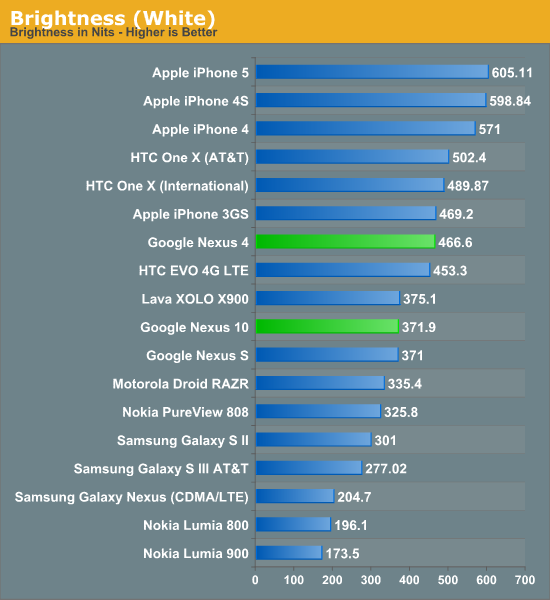
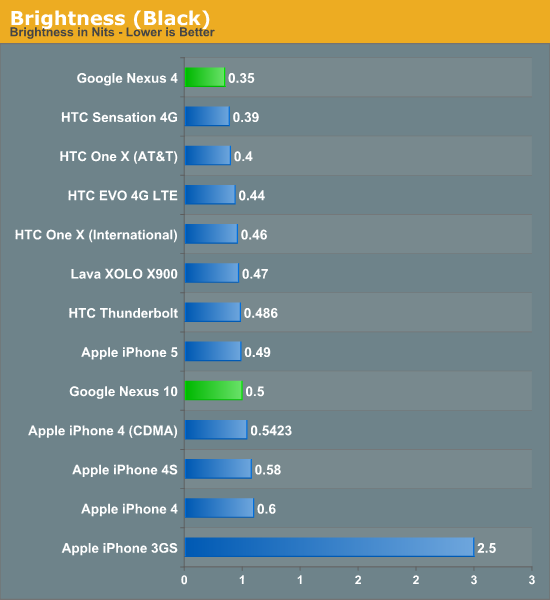
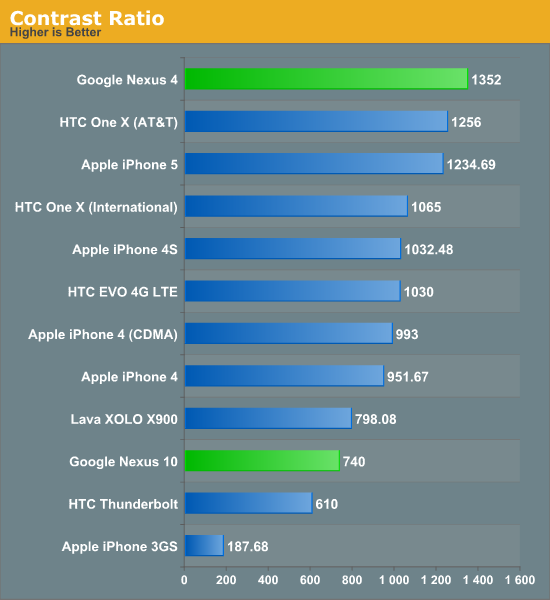
Final Words
We still have a lot of additional writing and testing ahead of us. Stay tuned for our full review of both devices!










244 Comments
View All Comments
medi01 - Saturday, November 3, 2012 - link
No SD card slot eh?Let me guess, "it's confusing".
No thanks, dear google.
will2 - Saturday, November 3, 2012 - link
Anand and teamI think your preview was useful in drawing attention to certain problems that need to be tackled in the full review.
I would like to ask that you heed 5 things in the full review;
1) It is good that you include a few older phones/tablets in your comparison with the 2 under review to give a historical perspective, but I think your table devotes too much space to some fairly obscure old models at expense of alternative buys to the 2 under review. Surely any comparative review should include all NEW flagship phones that people might buy as an alternative to those under review. You included the new LG Optimus G, in only a few graphs which left a very incomplete comparison. The SG3 has been updated to JB4.1 which gives different results but your graph does not tell you which you are comparing.
2) You have identified some big performance variations between the LG Optimus G and LG N4, indicating there may be design issues that need to be quickly fixed. They need to be fully investigated and Google's and LG's response to them, with a timescale to fixing the problem.
3) You identified unexplained performance differences between the 2 A15 based devices (N10 & Chromebook). They also need to be fully investigated and aired.
4) A number of posts suggest the Chrome Browser is not a useful benchmark. Need to carefully choose which benchmarks are used for the full review, to give the clearest objective picture.
5) I know your past full reviews have given detailed WiFi speed/distance benchmarks, so I trust your full review will include them, and also for the BT4, and a good test of the new Miracast wireless TV connection.
If Google/LG/Samsung are not able to fix the design issues quickly, I think it would be better that your full review is not released until they are, and perhaps publish an updated preview if the delay is long.
nickfer - Saturday, November 3, 2012 - link
Excellent suggestions. I would add:1. Please, please say what version of Android you are testing for each phone. When available, test multiple versions (say ICS and JB). I find this more important than testing very different phones. It's good to keep track of the software evolution, mostly when it involves very different kernels.
2. Be scientific. Select a number of phones you want to test and be consistent with it. Don't test some phones on some benchmarks on others. It's totally useless.
3. Test different browsers. You got Chrome and Firefox on Android. Test them both, at least that would tell if the performance hits are due to the software being tested or the hardware (at least to some extent).
cain_templar - Saturday, November 3, 2012 - link
The top / average / median numbers of Nexus 4 are way better on GLBenchmark website than your results.http://www.glbenchmark.com/phonedetails.jsp?D=Goog...
wymiata3 - Sunday, November 4, 2012 - link
Why wasn't this addressed? Apart from using a different operating system I believe the webkit should be pretty much the same, yet we see 1300ish ms vs. 650ish ms results.Jorange - Sunday, November 4, 2012 - link
Chrome OS in no doubt on a much newer version of webkit / V8. On the desktop going from version 18 to 19, brought a 25% improvement in sunspider scores alone.Specialist79 - Sunday, November 4, 2012 - link
Has the battery benchmark been performed with the same browser on all Android devices?Freedomuser - Sunday, November 4, 2012 - link
You guys rock! Very reliable reviews. Keep up the good work.Holy madness - Sunday, November 4, 2012 - link
In the 3G/4G battery performance chart, the iPhone 5 appears twice. In the tablet comparison, there is an "iPad 2.4". What is this? Make sure your tables are accurate before you post them or you lose all credibility.As a complete aside, I upgraded from an iPhone 4 to an iPhone 5 and while the 5 gets about 8 hours of 4G battery life, there is no way the 4 got anywhere near as poor as 3.5 hours. It got 8, too. Very suspicious.
thesavvymage - Sunday, November 4, 2012 - link
The iPad 2,4 is the 4th iteration of the iPad 2, the one with the 32nm processor shrink. Not a typo. This is one of the most reputable tech sites out there, it'd take something big to lose credibility. Not some simple reader error